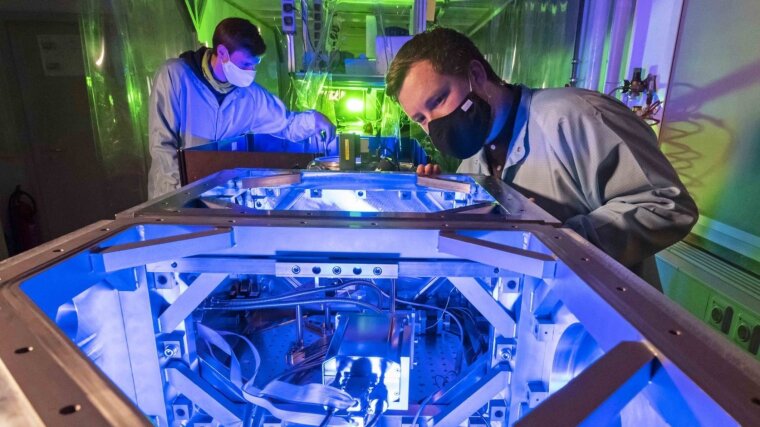
Optical microscopy has its limits – Ernst Abbe proved this in Jena by calculating the resolution limit of a microscope which is for visible light in the order of one micrometre. However, scientists are now attempting to shift this limit by looking for novel approaches. Among them are lens-less microscopes illuminated with short wavelength radiation (e.g. x-rays) resulting in images with nanometre resolution. A promising light source for this method is based on high harmonics generation of ultrashort lasers pulses in in gases.
By Sebastian Hollstein
High harmonics based sources emit spatially coherent light pulses at short wavelengths. These properties are necessary for spatially resolving objects measuring only a few nanometres and for observing dynamic processes. High harmonics are generated by shooting very high-intensity laser pulses into a noble gas. This results in a nonlinear interaction between the light and gas atoms: The electrons start oscillating in the light field and emit short-wavelength radiation – the high harmonics. If this extreme ultraviolet (XUV) light interacts with an unknown sample, the light’s properties will change. These changes provide information about the examined object. As the light has a very short wavelength, it can also be shone through samples that are not transparent to visible light (e.g. plasma).
What makes stars shine
Plasma is a highly excited state of matter consisting of ions and free electrons. This physical state is adopted by almost all visible matter in space, including stars, galaxies and interstellar matter. So, if we want to unearth the secrets of our universe, research into plasma is essential. Although plasma can be generated in the laboratory, we are still trying to understand the processes that take place in the ›turbulent‹ interior of this highly dense cloud of ions and free electrons. Prof. Dr Christian Spielmann and his team at the Institute of Optics and Quantum Electronics are cooperating with their colleagues around the world to take a closer look at this special physical state and literally ›shed light on the matter‹. And high harmonics are their most important tool.
The researchers have already had their first taste of success. In a paper published in ›Light: Science & Application‹, the team of researchers present a method that enables physicists to directly observe the formation and interaction of highly ionized krypton plasma with coherent ultraviolet light in the femtosecond range. »We first turned krypton gas into plasma by exciting it with a laser, and then we sent a coherent XUV probe pulse – a high harmonic – through the plasma. Its wavelength was so short that the XUV probe pulse was able to penetrate the plasma,« explains Spielmann. »As this second beam propagated through the plasma, it acquired the properties of the plasma«. Using a new X-ray scattering process, the researchers were able to read out the information and create an image of the spatial distribution of electrons and ions in the plasma.
How to make photovoltaic cells more efficient
High harmonics are also providing insights in other, more practical fields, and are even helping to combat climate change. For example, Spielmann is collaborating with Prof. Dr Michael Zürch from the University of California in Berkeley and colleagues from other disciplines on the ›QUESTforENERGY‹ project, where he is investigating new nanomaterials for use in photovoltaic cells. »As the efficiency of single-layer, silicon-based photovoltaic cells can hardly be increased, they’re not our best weapon when it comes to meeting rising energy demands,« says Spielmann. »We need alternatives». By combining various two-dimensional materials with different absorption spectra, we may be able to create photovoltaic cells which could cover a greater solar spectrum and would therefore be able to convert more light into electrical energy.
In order to find suitable materials, scientists must first investigate how their optical and electronic properties change when they are optically excited and how these optoelectronic properties can be controlled. How are charge carriers propagated in the material and what happens to the structure of the materials?
To observe these processes with temporal resolution (in the femtosecond range), the researchers are shooting high harmonics pulses through the excited sample and analysing the beam on the other side of the sample to follow the transient changes of the properties in in the two-dimensional material. From the changes they can find out how electrons made their way through the sample and how much time they need to cross the material.
Ghost imaging of biological samples
High harmonics could also be used when analysing biological samples under the microscope, because the short wavelength allows finer details to be resolved compared to illumination with visible light. However, there is a risk of damaging or even destroying organic samples due to the intense radiation. Although scientists have developed measuring methods with powerful X-ray lasers, where information can be collected before the objects are damaged, these processes are very complex. That’s why Spielmann and his team are exploring the possibility of an XUV ghost imaging process within the ›Balance of the Microverse‹ cluster of excellence.
In this process, the objects to be examined are not placed directly between the XUV light source and a camera. This is done by splitting the XUV beam into one intense beam, which creates the image in a camera without an object, and one weak beam, which simultaneously illuminates the object to be examined and then falls onto a photodiode. As both rays are correlated with each other, the object can be fully reconstructed by combining the information from both rays.
Original-Publication:
Nonlinear Ionization Dynamics of Hot Dense Plasma Observed in a Laser-Plasma Amplifier, Light: Science & Applications (2020), DOI: 10.1038/s41377-020-00424-2External link